The global pumpkin seed protein market is valued at USD 1.4 billion in 2025 and is expected to reach USD 2.2 billion by 2035, reflecting a CAGR of 4.6%. Factors supporting this growth include the rising popularity of plant-based protein, increasing demand for clean-label and allergen-free products, and the growing health consciousness among consumers.
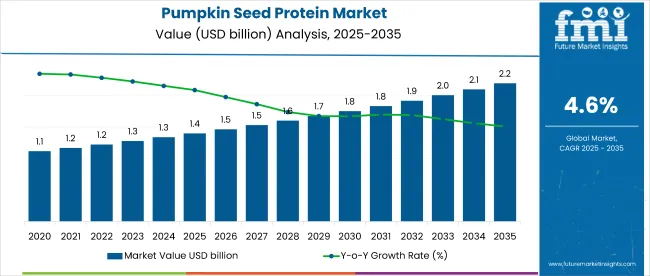
| Metric | Value |
|---|---|
| Estimated Size (2025E) | USD 1.4 billion |
| Projected Value (2035F) | USD 2.2 billion |
| CAGR (2025 to 2035) | 4.6% |
Additionally, the expanding application of pumpkin seed protein in dietary supplements, nutraceuticals, and bakery foods is expected to support steady revenue generation over the forecast period.
North America is expected to retain the largest share in the market from 2025 to 2035, led by the USA expanding at a moderate CAGR of 4.9%. Meanwhile, France and Japan are anticipated to register the fastest growth with prominent CAGRs of 5.2% and 5.0% respectively. By source type, the conventional segment will dominate 68% of the share, while the roasted seeds by nature segment is expected to lead with 56% of the market share in 2025.
The market accounts for a modest yet growing share across its parent markets. It holds approximately 2.5% of the global plant-based protein market, driven by rising demand for allergen-free and non-soy alternatives. In the functional food ingredients market, it contributes nearly 1.8%, primarily through bars, beverages, and ready-to-eat meals.
Within the vegan market, its share is around 3.2%, reflecting consumer preference for clean-label, organic products. It holds close to 2% in the nutritional supplements and dietary supplements markets, particularly in sports nutrition and metabolism-enhancing applications. These shares are expected to increase steadily by 2035.
Looking ahead, innovation in protein extraction methods, the expansion of e-commerce distribution, and favorable government regulations around plant-based protein labeling are expected to propel market expansion. The increasing application of pumpkin seed protein in vegan supplements, cosmetic formulations, and energy nutrition bars will offer new revenue opportunities.
Furthermore, consumer education and strategic branding are expected to shape the future direction of the market. Growing R&D investments by manufacturers and collaborations with food tech companies are likely to further enhance product quality and expand application areas across emerging economies.
The market is segmented by source, nature, end use, and region. By source, the market is segmented into organic and conventional. By nature, the market is divided into raw and roasted. By end use, the market includes beverages, bakery, dairy, sports nutrition, ready-to-eat meals, savory snacks, nutrition bars and breakfast cereals. By region, the market covers North America, Latin America, Europe, East Asia, South Asia, Oceania, and the Middle East & Africa.
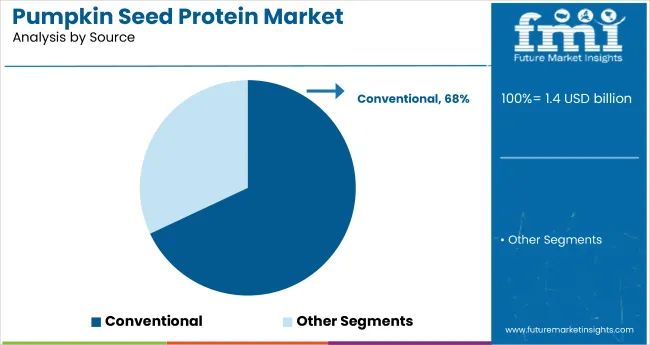
The conventional segment is expected to account for the largest share in 2025, capturing 68% of the global market. Its broad availability and lower cost make it the preferred choice for large-scale manufacturers. Additionally, conventional pumpkin seed protein is widely used in bulk applications such as protein powders and functional foods due to streamlined supply chains and consistent quality.
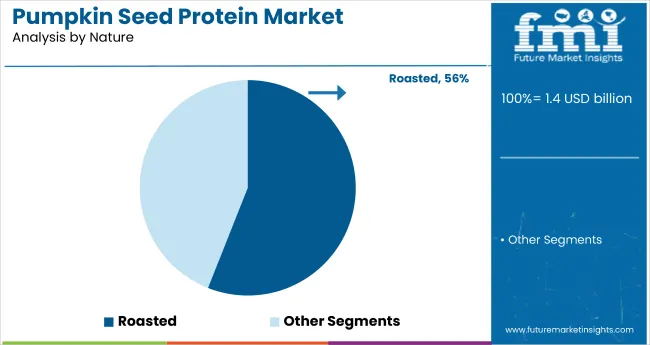
The roasted segment is projected to lead the market with a 56% share in 2025, driven by its enhanced flavor and extended shelf life. Roasting improves the palatability and application versatility of pumpkin seed protein, making it popular in snacks, cereals, and sports nutrition. It also reduces anti-nutrients, increasing its appeal among health-conscious consumers seeking natural yet flavorful protein sources.
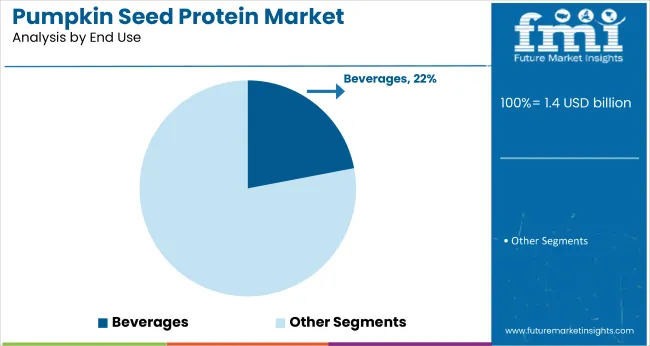
The beverage segment is projected to hold the leading share of 22% in 2025, driven by the growing inclusion of plant-based proteins in smoothies, health drinks, and fortified beverages. Pumpkin seed protein’s solubility, clean taste, and neutral profile make it well-suited for ready-to-drink (RTD) beverages targeting fitness-conscious and vegan consumers.
Recent Trends in the Pumpkin Seed Protein Market
Key Challenges in the Pumpkin Seed Protein Market
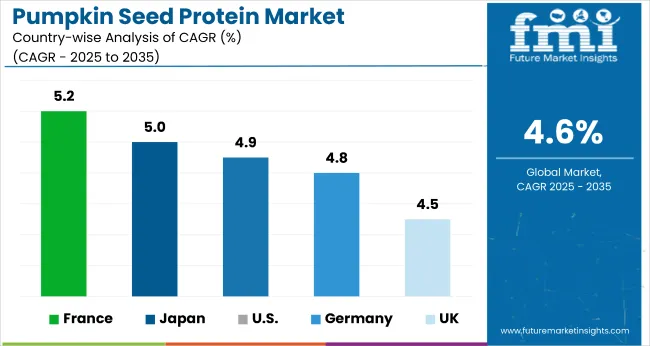
Among the top five countries analyzed, France is projected to witness the highest growth in the global market, expanding at a CAGR of 5.2% from 2025 to 2035. This growth is supported by a strong plant-based movement, government initiatives toward sustainable food systems, and rising consumer interest in allergen-free, nutrient-dense protein alternatives. Japan follows closely with a 5% CAGR, fueled by an aging population increasingly seeking functional foods for muscle maintenance and general wellness.
In the USA, the market is expected to grow at 4.9%, driven by consumer demand for clean-label, high-protein snacks and beverages. Germany, at 4.8% CAGR, benefits from a mature organic food sector and increasing flexitarians. The UK, while slightly slower, will expand at a 4.5% CAGR as veganism and demand for ethical protein sources continue to gain traction. These trends signify a strong and sustained global pivot toward plant-based protein consumption.
The report covers an in-depth analysis of 40+ countries; five top-performing OECD countries are highlighted below.
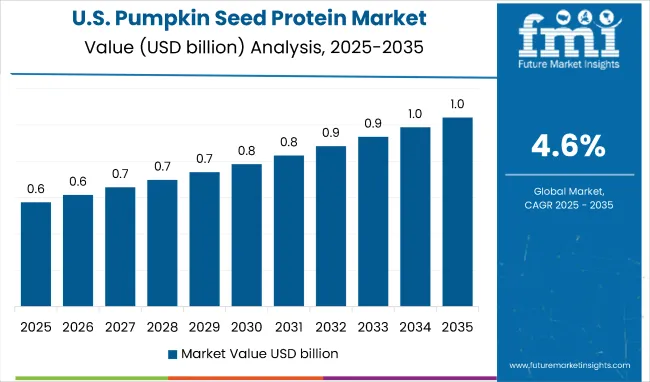
Pumpkin seed protein revenue in the USA is projected to grow at a CAGR of 4.9% from 2025 to 2035. The USA remains the largest global consumer and importer of pumpkin seed protein, driven by a booming health supplement industry and rising demand for plant-based nutrition. Functional food manufacturers are incorporating it into bars, beverages, and meal replacements.
The pumpkin seed protein market in the UK is projected to grow at a CAGR of 4.5% from 2025 to 2035. Rising veganism and growing demand for allergen-free protein alternatives have strengthened the country’s position in the European market. British consumers favor organic, sustainable, and ethical protein sources, driving increased imports of organic pumpkin seed powder.

Pumpkin seed protein sales in Germany are forecast to grow at a CAGR of 4.8% from 2025 to 2035. As a leading European market for natural and organic foods, Germany is leveraging its strong food manufacturing base to incorporate pumpkin seed protein into gluten-free, functional, and high-protein products. Domestic production and partnerships with Eastern European suppliers support localized processing.
Pumpkin seed protein revenue in France is projected to grow at a CAGR of 5.2% through 2035. The rising trend of flexitarianism and government-backed initiatives to reduce red meat consumption are key demand drivers. French food brands are incorporating pumpkin seed protein into soups, ready-to-eat meals, and fortified snacks to meet consumer demand for functional and sustainable nutrition.
The pumpkin seed protein market in Japan is projected to grow at a CAGR of 5.0% from 2025 to 2035, driven by rising demand for functional foods and nutraceuticals among the aging population. Pumpkin seed protein is gaining traction in supplements, traditional health drinks, and powdered formulations targeting gut health and metabolic support.

The global market is moderately fragmented, with a mix of regional specialists and global suppliers competing for market share. Major players include AIDP Inc., Bioriginal Food & Science Corporation, Jarrow Formulas, Bio Planète Ölmühle Moog GmbH, and The Green Labs LLC, who are actively driving innovation and distribution across food, beverage, nutraceutical, and sports nutrition industries. These companies are focused on expanding their clean-label protein portfolios and building global supply chain capabilities to meet the rising demand for plant-based ingredients.
Company strategies are centered on product innovation, strategic partnerships, global distribution expansion, and organic certifications. Leading suppliers are emphasizing allergen-free claims, functional health benefits, and compatibility with vegan and keto diets.
Firms like AIDP Inc. and Bioriginal are strengthening their raw material sourcing from Mexico and Europe, while others are entering contract manufacturing agreements to support scaling needs. Innovation in formulation (e.g., roasted seed blends and flavored protein powders) and increasing investment in EU and USA organic certifications are also key competitive levers.
| Report Attributes | Details |
|---|---|
| Current Total Market Size (2025) | USD 1.4 billion |
| Projected Market Size (2035) | USD 2.2 billion |
| CAGR (2025 to 2035) | 4.6% |
| Base Year for Estimation | 2024 |
| Historical Period | 2020 to 2024 |
| Projections Period | 2025 to 2035 |
| Market Analysis Parameters | Revenue in USD billions / Volume in kilotons |
| By Source | Organic and Conventional |
| By Nature | Raw and Roasted |
| By End Use | Beverages, Bakery, Dairy, Sports Nutrition, Ready-to-Eat Meals, Savory Snacks, Nutrition Bars, Breakfast Cereals, Others (Pet Food, Meat Substitutes) |
| Regions Covered | North America, Latin America, Europe, Middle East and Africa, East Asia, South Asia, Oceania |
| Countries Covered | United States, Canada, United Kingdom, Germany, France, China, Japan, South Korea, Brazil, Australia and 40+ Countries |
| Key Players | AIDP Inc., Bioriginal Food & Science Corporation, Jarrow Formulas, Inc., Bio Planète Ölmühle Moog GmbH, BI Nutraceuticals, Seed Oil Company, Organic Friends & Sports GmbH, The Green Labs LLC, Omega Nutrition USA Inc., and W. Kündig & Cie AG. |
| Additional Attributes | Dollar sales by value, market share analysis by segments, and country-wise analysis |
The global pumpkin seed protein market is estimated to be valued at USD 1.4 billion in 2025.
The market size for the pumpkin seed protein market is projected to reach USD 2.2 billion by 2035.
The pumpkin seed protein market is expected to grow at a 4.6% CAGR between 2025 and 2035.
The key product types in pumpkin seed protein market are organic and conventional.
In terms of conventional, nature segment to command 0.0% share in the pumpkin seed protein market in 2025.






Our Research Products

The "Full Research Suite" delivers actionable market intel, deep dives on markets or technologies, so clients act faster, cut risk, and unlock growth.

The Leaderboard benchmarks and ranks top vendors, classifying them as Established Leaders, Leading Challengers, or Disruptors & Challengers.

Locates where complements amplify value and substitutes erode it, forecasting net impact by horizon

We deliver granular, decision-grade intel: market sizing, 5-year forecasts, pricing, adoption, usage, revenue, and operational KPIs—plus competitor tracking, regulation, and value chains—across 60 countries broadly.

Spot the shifts before they hit your P&L. We track inflection points, adoption curves, pricing moves, and ecosystem plays to show where demand is heading, why it is changing, and what to do next across high-growth markets and disruptive tech

Real-time reads of user behavior. We track shifting priorities, perceptions of today’s and next-gen services, and provider experience, then pace how fast tech moves from trial to adoption, blending buyer, consumer, and channel inputs with social signals (#WhySwitch, #UX).

Partner with our analyst team to build a custom report designed around your business priorities. From analysing market trends to assessing competitors or crafting bespoke datasets, we tailor insights to your needs.
Supplier Intelligence
Discovery & Profiling
Capacity & Footprint
Performance & Risk
Compliance & Governance
Commercial Readiness
Who Supplies Whom
Scorecards & Shortlists
Playbooks & Docs
Category Intelligence
Definition & Scope
Demand & Use Cases
Cost Drivers
Market Structure
Supply Chain Map
Trade & Policy
Operating Norms
Deliverables
Buyer Intelligence
Account Basics
Spend & Scope
Procurement Model
Vendor Requirements
Terms & Policies
Entry Strategy
Pain Points & Triggers
Outputs
Pricing Analysis
Benchmarks
Trends
Should-Cost
Indexation
Landed Cost
Commercial Terms
Deliverables
Brand Analysis
Positioning & Value Prop
Share & Presence
Customer Evidence
Go-to-Market
Digital & Reputation
Compliance & Trust
KPIs & Gaps
Outputs
Full Research Suite comprises of:
Market outlook & trends analysis
Interviews & case studies
Strategic recommendations
Vendor profiles & capabilities analysis
5-year forecasts
8 regions and 60+ country-level data splits
Market segment data splits
12 months of continuous data updates
DELIVERED AS:
PDF EXCEL ONLINE
Rapeseed Protein Market Size and Share Forecast Outlook 2025 to 2035
Assessing Rapeseed Protein Market Share & Industry Trends
Watermelon Seed Protein Market Analysis - Size, Share & Forecast 2025 to 2035
Protein-Coating Line Market Forecast Outlook 2025 to 2035
Seed Paper Bag Market Size and Share Forecast Outlook 2025 to 2035
Seed Processing Equipment Market Size and Share Forecast Outlook 2025 to 2035
Protein Labelling Market Size and Share Forecast Outlook 2025 to 2035
Seed Treatment Materials Market Size and Share Forecast Outlook 2025 to 2035
Protein Puddings Market Size and Share Forecast Outlook 2025 to 2035
Protein/Antibody Engineering Market Size and Share Forecast Outlook 2025 to 2035
Protein Expression Market Size and Share Forecast Outlook 2025 to 2035
Seed Biostimulants Market Size and Share Forecast Outlook 2025 to 2035
Seed Health Market Size and Share Forecast Outlook 2025 to 2035
Protein Purification Resin Market Size and Share Forecast Outlook 2025 to 2035
Protein Hydrolysate For Animal Feed Application Market Size and Share Forecast Outlook 2025 to 2035
Protein Crisps Market Outlook - Growth, Demand & Forecast 2025 to 2035
Seed Additives Market Analysis - Size and Share Forecast Outlook 2025 to 2035
Protein Hydrolysate Market Size and Share Forecast Outlook 2025 to 2035
Protein Supplement Market - Size, Share, and Forecast 2025 to 2035
Protein Powder Market Analysis - Size, Share, and Forecast Outlook 2025 to 2035

Thank you!
You will receive an email from our Business Development Manager. Please be sure to check your SPAM/JUNK folder too.
Chat With
MaRIA